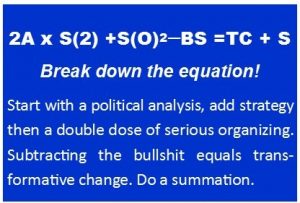This is the sixth article of a 7-part series that will focus on the issues in our radical movements that I think need our immediate and ongoing attention. I am using the ancient eastern concept of chakras for the body as a parallel to our movement’s energy wheel. Healers believe sickness occurs when the body’s chakras are blocked or out of alignment. Likewise, the U.S. Left and our social justice movements need our collective introspection, analysis and adjustments that lead to unblocking our energy/chi points. A weakened Left, and especially the Black Left, have been unable to provide this critical guidance over the last twenty years. I do not have the space to go too deep into my thinking although I have been pondering and talking about this very subject for a few years now. I am looking to stimulate a higher level of principled discussion about how to energize and organize the social forces coming into play at this pivotal juncture in history and how we can rebuild a formidable radical movement in this country.
Read all the articles at BlackCommentator.com
“We are airing our shame and failures because we want you, our movement sisters and brothers, to tuck lessons from this trauma into your sewing kits and toolboxes to create sturdier organizations in your communities.”
-Sharing Sorrow: Women of Color Resource Center’s Downfall, Community Taskforce Findings, March 2011

There are several terms used to critique if we are effective in what we are building and how we are doing it. Evaluation, assessment, review. I’m most accustomed with the word summation, as in creating a culture of summation in an organization. Summations are important because they validate whether our political analysis and strategy were realistic. Ultimately, it should help us improve our internal functioning and organizing. Without regular, thorough and collective assessments, this chakra gets clogged. When this happens, our political analysis becomes dull and our development is stagnated.
Summing up our practice or a campaign should be a routine part of organizational planning. When we sum up a program or campaign, the starting point is if we achieved the stated goals and objectives. These are based upon our analysis of conditions and capacity and how the program/campaign fitted in with our overall strategy. A summation can vary in depth from a cursory assessment to looking at all the elements of the campaign including the roles of individuals.
There are times when our organizations should sum up a trend that is harmful to its members or to the organization. For example, if there is factionalism (political clique) brewing, the tendency must be critiqued and steps put forward to eliminate the disruptive trend. Then there must also be a summation to determine if those steps were successful in rooting out the negative behaviors. Remember, it’s all about saving the patient(s).
A summation gives us guidance on what are our strengths and weaknesses. Where there are strengths, our organizations can build on them. Where there are weaknesses, we can map out what we need to get it together including more study, trainings and mentoring. Our movement is anemic on study; it’s easier to argue about opinions than to assert a historical analysis based upon facts. Memes can be clever in delivering a short, powerful message but they are no substitute for a disciplined dive into theory, ideology and philosophy. We must strive for the same command of issues like critical race theory or market economy as we have of our protest chants.
One of the most poignant and in-depth summations that I have read in recent times was on the demise of the Women of Color Resource Center (WCRC). This kick-ass group of sistahs had been doing the critical work around women’s issues for nearly two decades. The leadership torch was passed from Linda Burnham to a new director. Two years later, the organization crashed and burned. The support community around WCRC took the extraordinary steps to find out what happened and to publicly share those hard lessons with the movement. The findings of the community task force that was convened are very detailed; they include a letter of desperation from the board to the larger community, financials and even summaries of staff interviews. A sentence in the report always feels like a kick in the gut, “…with the writing and sharing of this report with you, we are now ready to scatter the ashes of our beloved organization.” Damn.
I hadn’t read the report since it was circulated and it’s just as heartbreaking now as it was then. Reading it again made me realize that it encompasses all the chakras I have written about. It’s all there in painstaking detail why our movement must focus on transformative work on ourselves and in our organizations. Right around the same time as the fall of WCRC, the National Center for Human Rights Education also bit the dust. Founded by Loretta Ross, the center was handed off to a new executive director after a decade of exemplary leadership by Ross. Like the Resource Center, the crew at NCHRE had engaged in a serious vetting process. Sadly, the vetting did not guarantee a successful transition in either case.
We can go up and down history and study what took down organizations from the Universal Negro Improvement Association (UNIA) to the League for Revolutionary Struggle (LRS). We could, but we’re too busy making the same mistakes. Too often, we don’t take the time to reflect and understand what worked and what didn’t; we jump right into the next project.
The great thing about summations is that you must be doing work to have something to sum up. New and younger activists are looking for best practices in organizing and movement building. Our movements have a responsibility to them and to ourselves to document our successes as well as our failures in as many creative forms as possible. Let the summation do the talking–in the words of the people who did the work.



